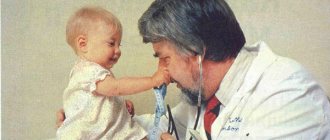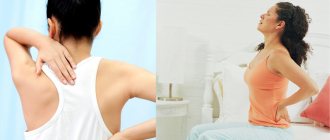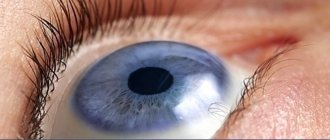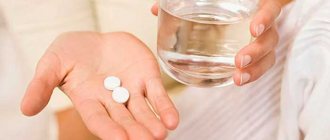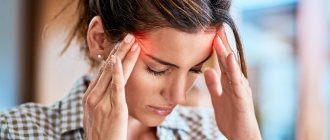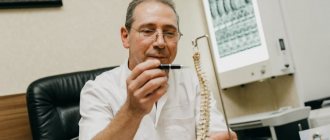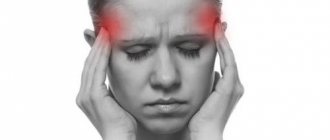Everyone has experienced headaches (cephalalgia). The cause of the occurrence can be absolutely anything: from serious disturbances in the functioning of the body to minor ones. But it is worth noting that painful pulsation in the head is a “bell” in order to go for a diagnosis.
This type of pain may indicate serious problems.
The main causes of cephalalgia
Acute pain in the head and throbbing prevents a person from living a normal life and doing business. If pain appears once, this does not necessarily indicate the presence of dysfunction in the body. In cases where a person experiences cephalalgia more and more often, and the pain lasts longer and longer, there really is a problem in the body. It needs to be eliminated, and only a specialist can handle it.
Doctors identify a number of main reasons that cause this symptom, namely:
- VSD (vegetative-vascular dystonia);
- atherosclerosis;
- sinusitis, sinusitis;
- migraine;
- eye diseases;
- hematomas;
- tumors;
- neuralgia;
- stress.
Vegetovascular dystonia
Pulsating pain is called background pain. It occurs due to a decrease in the tone of cerebral vessels, stagnation of blood, and spasms of the arteries. The difference between pain that appears due to VSD is that “jolts” do not depend on the person’s pulse.
Atherosclerosis
If a patient has problems with the vascular system, he begins to suffer from pulsation in the temporal and occipital areas of the head. But the zones can change, and the sensations can become oppressive over time.
Sinusitis, sinusitis
The reason lies in the cold you suffered, namely its complications. In order not to encounter cephalalgia, it is imperative to cure all viral and infectious diseases. The same applies to a runny nose.
Migraine
Migraine is manifested by a pulsation, which patients describe as if it were pounding right under the skin, and the pain is localized in one part of the head at the top.
Scientists have not yet proven the definitive causes of such pain, and the exact forms of manifestation of the disease have not yet been determined.
But still, there are several possible causes of migraine development, namely:
- food products (several types of cheeses and sausages);
- weather sensitivity;
- smells of ammonia, ammonia, perfume;
- serious physical activity;
- emotional outburst;
- uncomfortable body position for a long time.
A migraine can torment a person for more than one day. There are cases when the pain lasts 3 days. Most often, cephalalgia caused by this problem manifests itself in unbearably severe pain, and can go away after a few hours. Doctors note the fact that females suffer more from this.
At the end of a migraine attack, a person notes that he has severe weakness and a tendency to sleep.
Eye diseases
The following reasons that can provoke pulsation are eye diseases. A large number of people turn to specialists with complaints such as blurred vision, nausea, dizziness, photophobia, and acute pain radiating to the eye. A competent doctor will immediately determine that these are symptoms of angle-closure glaucoma - high intraocular pressure.
Cephalgia can develop due to tension in the optic nerve, which occurs due to incorrectly selected diopters of glasses or lenses. But in such cases, dizziness also appears.
Hematomas, tumors
Pulsating pain of a strong nature, which is clearly localized in one of the areas of the head, may indicate the presence of damage or a neoplasm. Also in this case, it is worth noting the presence of nausea and vomiting.
If such symptoms are noticed, you must quickly contact a specialist to diagnose a tumor or other problem and begin to treat it.
Stress
All overwork and emotional turmoil can result in severe headaches. Constant nervous tension and stress can create a “fellow traveler” for you for the whole day, namely cephalgia.
Neuralgia
Another common reason why such unpleasant sensations occur in the temple and head area. Dental problems, trigeminal neuralgia - all this provokes pain.
Other causes of cephalalgia
Osteochondrosis and a number of other problems associated with the cervical spine can provoke throbbing pain.
In winter, pulsation in the back of the head often occurs. This is explained by hypothermia and a sharp narrowing of blood vessels.
Lack of normal rest, disruption of sleep quality and routine can cause headaches.
Bad habits are also included in this list of “provocateurs”. They not only harm health, but can also cause discomfort to a person in the form of cephalgia. If a person often drank coffee and decided to abruptly stop, this can also provoke this problem, since the blood vessels are not able to return to normal so quickly.
Not everyone knows, but what we eat can also cause throbbing in our temples. These products include: chicken liver, cheeses, sausages, bacon, nuts, yogurt.
Treatment
First aid! These are standard medications. Analgesics and antispasmodics are suitable. Experts recommend citramon, aspirin, analgin, ibuprofren, tampalgin, nimesulide and others containing paracetamol.
Attention! Frequent use of painkillers is unacceptable! Uncontrolled use of pills leads to disruption of the brain and cardiovascular systems. Doing this all the time is prohibited! If there is no result, you must seek the help of a doctor.
Silence, warmth and darkness are helpful for headaches. Avoid places with loud music, bright lighting and cold.
To relieve attacks, it is advisable to adopt folk remedies and the healing properties of medicinal herbs. Teas made from peppermint, rosemary, chamomile, thyme, St. John's wort, oregano with the addition of lemon juice will help.
It is necessary to eliminate mental stress.
The recipe for making tinctures is simple. A tablespoon is poured into a glass of boiling water and heated in a water bath for a quarter of an hour. Take 3 times a day before meals.
A good way to eliminate unpleasant sensations is massage and, as an option, self-massage. Using your fingertips, massage the left side of your head, temple. It is necessary to start from the place of local pain, gradually covering the entire area of the head.
Wet, cool vinegar compresses will relieve acute attacks. Compresses made from white cabbage leaves and citrus fruits will also help.
Relief will come from rubbing mint and eucalyptus oils into the temple area.
Aromatherapy - inhalation of substances with a soothing scent (lavender, mint, rose, pine). This significantly reduces pain and brings calm to the nervous system.
A warm bath will improve blood circulation and tone the body. A contrast shower can also solve these problems.
A warm towel, heated by an iron or on a radiator, pulled tightly over the head will ease suffering.
Cephalgia in children
Pulsating discomfort in a child that is not accompanied by fever, cough and runny nose should alert parents. In such cases, it is important to consult a doctor. Such manifestations may indicate problems with the child’s health.
The phenomenon can be triggered by:
- disease of the vascular system;
- neuralgia;
- migraine;
- injury;
- emotional condition;
- poor nutrition;
- the presence of provoking external factors.
Cephalgia and pregnancy
Most often, girls in this position suffer from migraines, and the illness appears from physical activity, food, lack of sleep, stress, and fatigue. There are also other reasons that cause throbbing pain in women in the position:
- VSD;
- blood pressure problems;
- problems with blood supply;
- voltage;
- disorders in the brain;
- sinus inflammation;
- glaucoma.
For pregnant women suffering from cephalalgia, there are recommendations to combat discomfort, namely:
- do a light massage;
- restful sleep;
- take a contrast shower.
Regarding pain relief with medications, in this case it is important to consult a specialist, since not all painkillers are approved for pregnant women.
Therapy for cluster headaches
Drug treatment may be prescribed by a neurologist after receiving the research results. For an accurate diagnosis, it is often necessary to undergo an MRI of the brain and electroencephalography. If the exact cause of beam cephalgia is not known, until the exact diagnosis is determined, the pain can be relieved with the following medications:
- Ketorol is a powerful prescription pain reliever that relieves even the most severe pain ten to fifteen minutes after administration.
- "Moment". The active ingredient of the drug is ibuprofen. It is a fast-acting, effective anti-inflammatory and analgesic medicine. Sold at any pharmacy without a prescription.
- "Citramon" is the most popular and cheapest analgesic, which also contains caffeine. Gives vigor and has a stimulating effect.
With a sharp point pain in the head, most people prefer to take a tablet of a potent analgesic. This approach is questionable: the attack of pain will return, and more than once. Stopping it every time with pills is wrong. It is better to undergo a full diagnosis once, find out the cause of the pain and take a course of medications that will eliminate the cause of the disease and prevent recurrence of pain.
Elderly age
The older a person is, the more often he suffers from throbbing pain in the head, and most often this is associated with pressure and changes in the cervical spine. But there are also a number of reasons that pose a danger to older people, and these include:
- presence of a tumor in the brain;
- presence of hematomas in the brain;
- trigeminal neuralgia;
- temporal arteritis;
- intoxication;
- presence of infectious diseases;
- stroke.
Pain in the head can also be a consequence of menopause in women, weather sensitivity, which occurs in any gender, and depression.
The relationship and difference between point pain and regular migraine
Point cephalalgia is often a component of other types of headaches:
- “Tension pain” is a concept in neurology that arose a long time ago and is still relevant today. It occurs in both men and women due to severe nervous and physical fatigue. It is expressed not only in point cephalgia, but also in the fact that the forehead and back of the head hurt (the localization and nature of the pain changes on average once an hour). At the same time, the patient feels nausea, dizziness, and may lose consciousness. A good night's sleep is often enough to stop these symptoms. If the patient is unable to fall asleep on his own, he should resort to taking a sleeping pill.
- Histamine pain. In 40% of cases it is associated with pain of a primary nature. One type of migraine can act as a harbinger of another and change the patient’s condition. For example, the condition begins as a migraine with aura, and after an hour it develops into an ophthalmoplegic form.
- Cranialgia is a condition that occurs when the trigeminal nerve becomes inflamed. This is a common reason why the back and top of the head hurt. Cranialgia is characterized by lumbago in the form of short-term impulses. Most often, this condition does not require any special treatment and goes away after the inflammatory process of the trigeminal nerve stops.
Causes of pain by nature and location
You can determine the cause of throbbing pain in the head by analyzing the place where the patient feels it. Sensations can move around the skull, but most often they appear in a specific part.
Pain in the back of the head
Pain in this part of the skull is characteristic of high blood pressure. It also manifests itself as a pressing character, becoming more pronounced if you turn and tilt your head. It is worth noting that such a sensation in the back of the head can warn of the development of a stroke.
But there are also such provoking factors that cause pain in the back of the head as diseases of the cervical spine, namely:
- scoliosis;
- osteochondrosis.
The pain disappears when the cause is eliminated, and with it the patient feels a relieved state in the shoulders and neck, cramps disappear, and sleep improves.
Pain on the left
Characteristic of migraine. Associated symptoms:
- visual impairment;
- disturbance of consciousness;
- dizziness;
- nausea;
- photophobia;
- loss of orientation.
Pain on the right
Pulsation of a jerking nature indicates trigeminal neuralgia. The pain affects the area of the eye, forehead, temple and jaw. In cases where the pain persists, you need to consult a doctor.
Discomfort in the temporal region
A number of diseases can manifest themselves in this way, for example:
- trigeminal neuralgia;
- migraine;
- increased blood pressure;
- intoxication;
- VSD.
Frontal region
Pain in the frontal part of the head is accompanied by convulsions, disturbances of consciousness and blurred vision. They may indicate increased intracranial pressure.
Also, pain in the forehead can be caused by sinusitis, respiratory infections and eye diseases. It may also be the result of the development of a malignant brain tumor.
Discomfort when moving your head
If unpleasant pulsating sensations in the head become more pronounced while moving the head, this may indicate diseases such as:
- neuritis;
- osteochondrosis;
- inflammation of the sinuses.
Symptoms typical for such cases are:
- nausea;
- prostration;
- dizziness;
- fever;
- partial paralysis
Patients with such complaints are promptly sent for hospitalization and treatment.
Pain and nausea
The cause of such changes in the body may be food poisoning. Throbbing in the head and nausea indicate changes in the brain or nervous disorders. The attack can also be triggered by head injuries.
Pulsation in the head without accompanying pain
The most common cause of such changes is disruption of the central nervous system or cardiovascular system.
Causes of neck pain on the left side
It becomes clear that the area around the neck on the left can hurt for many reasons. It is worth learning more about each disease and determining the symptoms in order to roughly understand what triggered the development of pain and discomfort in the neck.
Osteoarthrosis and osteochondrosis
Osteochondrosis manifests itself in the fact that the cartilage tissue of the spinal column gradually begins to deteriorate. The intervertebral discs become thinner, the distance between them decreases, and nerve roots are pinched. Osteoarthritis also affects the joints of the spinal column.
Neck muscle damage
One of the most common cases of neck pain is damage to muscle tissue. If you hit yourself or simply overstrain your muscles by being in a not very comfortable position for a long time, or get too cold, inflammation may begin, accompanied by pain and sometimes fever.
How to quickly relieve an attack of cephalalgia
In cases where a headache does not appear frequently or systematically, and a person definitely does not have diseases that can provoke it, then you can deal with the discomfort on your own. To do this, it is not necessary to use strong medications and call a doctor.
When you feel a severe headache, forget about bad habits, such as smoking and give up alcohol. You should also not apply ice or increase the dose of the analgesic yourself unless your doctor recommends it.
There are a number of actions that need to be taken so that a person with a headache begins to feel better, namely:
- Bring fresh air into the room.
- Free the patient from tight clothing and constricting jewelry, unbutton the shirt collar and raise his legs so that they are higher than head level.
- Reduce indoor lights and sounds to a minimum.
- Give water, it can also be a decoction of soothing and relaxing plants.
- Take a warm foot bath and apply a compress to your head.
- It is necessary to warm a person in cases where the pain intensifies and there is chills.
- Lightly massage the temple area, neck, head, while the person should lie down.
If the above methods do not help within 30 minutes, and only get worse, give the patient an analgesic. If this does not help, then call the ambulance doctors.
Cluster headache: symptoms
A rarer and more complex manifestation of point headache is cluster cephalgia. Doctors also call it cluster, histamine or Horton’s, depending on the location and nature of the pain. It manifests itself in the following symptoms:
- pain in the temporal artery during the next attack;
- discomfort and pain only on one side (not always), in the temple area;
- cephalalgia can develop at night - and often the patient is forced to wake up from the intensity of the painful sensations;
- the duration of the attack varies - most often it is five to six minutes, but in rare cases it can last for hours before taking the anesthetic;
- swelling of the nasopharynx and lacrimation;
- constriction of the pupils.
When to contact a specialist
The appearance of a throbbing headache is already a “bell” that you need to see a doctor and get checked. And few people know that there are situations that oblige the patient to contact a specialist to alleviate the condition, and sometimes even save a life.
If you notice that:
- The pain lasts for more than one hour, and medications do not help.
- The pulsation becomes stronger, despite the fact that the patient does nothing.
- Pain in the occipital region appears immediately after a person wakes up or awakening occurs due to unbearable sensations that do not allow doing anything.
- A buzzing sensation is often felt in a certain area of the head.
- The pain causes dizziness, nausea, vomiting, partial paralysis, clouding of consciousness, and inability to speak normally.
- Intense pulsating beats that do not stop for several days.
- Changes in blood pressure, which are accompanied by headaches.
- The nature of the throbbing pain constantly changes.
If you notice any of the above changes, you should immediately consult a doctor or an ambulance, as serious problems may be hidden behind this.
How does it manifest?
The first description of a headache appeared about 5 thousand years ago. The stabbing pain is sometimes compared to being struck by lightning or being pricked by a piece of ice. As a rule, it is sharp, sharp, piercing. This condition most often occurs in adults, but 3% of such problems are recorded in children.
In most cases, the pain is felt within 1 second, sometimes the attack lasts up to 10 seconds. There may be one “prick” or a whole series of “pricks”. The frequency of occurrence of painful sensations ranges from several hours to several days.
Most often, painful sensations are localized at one point:
in the temporal region; in the area of the eye sockets; at the top of the head; in the back of the head; in the forehead area; behind the ear.
The injections may move from point to point within one half of the head or appear on the other side.
